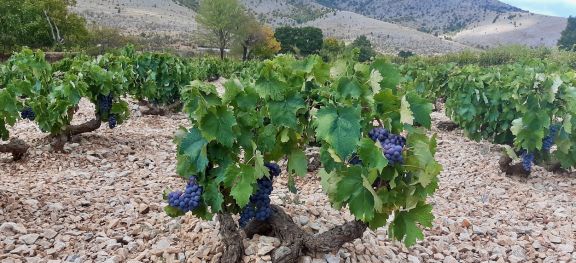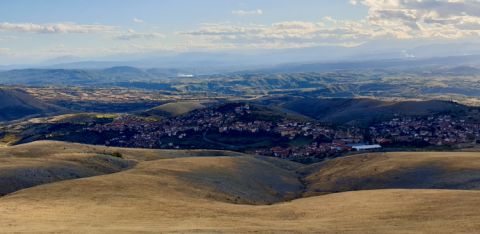Diamantis Moschomavro 2018 Siatista

More evidence of the treasure trove that is Greece's vines and vineyards.
From €14.40, $21, £17.25
Greece, like Portugal, is an Aladdin’s cave for lovers of local grape varieties, their revealing flavours and chequered histories.
Although Moschomavro means ‘black Muscat’, it is not genetically related to the white variety Muscat Blanc à Petits Grains (Moschato Aspro in Greece) and I didn’t detect any Muscat flavours in this wine. It’s grown almost exclusively in the mountainous region of Siatista, south-west of Kozáni in western Macedonia (see this overview map of Greece).
That the variety is now thriving, if on a very small scale, is thanks largely to owner and winemaker Dimitris Diamantis (below), who told me the story of this variety with typically light tannins and moderate to fresh acidity which existed mainly in Siatista, but also in other parts of northern Greece. Its role was typically to ‘strengthen’ Xinomavro (ie to increase the sugar content), which was often difficult to ripen fully, for the production of dry reds and of sweet wines rather than as a varietal wine. Diamantis is currently the only producer making a 100% Moschomavro wine and there are now just a few producers using it in a red or rosé blend.
‘As years passed by, the vines faded into obscurity and by the 1970s some Moschomavro vines remained only in old geriatric vineyards in Siatista. In the early 1990s we focused our energies on protecting and reviving the variety. We managed to save enough genetic material – my father, Konstantinos Diamantis, personally picked and transferred the cuttings to the plant nursery Vitro Hellas. After it had been registered and propagated, we planted a 3-ha [7.5-acre] vineyard on clay-limestone slopes in the Magoutes area of Siatista at an elevation of 850 m [2,790 ft].’ This, in my opinion, is the source of the wine’s great freshness.
He added proudly that any new plantings of Moschomavro elsewhere in Greece are the result of the original plant material from the Diamantis vineyard, now available to anyone via Vitro Hellas.
I first tasted this wine late last year thanks to a sample sent to me by UK Greek food and wine specialist Maltby & Greek, and then again more recently in a Noble Rot mixed case designed to lift spirits during lockdown, and presumably to divert wines that could no longer be sold in their locked-down restaurants. (I was delighted to see it was still on the list of Noble Rot Soho on Saturday night two weeks ago, just before it was shuttered once more.)
On both occasions I found the lightly coloured red to be charmingly fragrant with aromas and flavours of tangy red fruits and a quality that I can only describe as ‘dusty’ but in a good way, like crushed stones. It’s beautifully balanced between the lightish tannins, fresh acidity and lively fruit. It carries its 13.5% alcohol effortlessly and the flavour lingers to a long, mouth-watering finish. You could drink it on its own as an appetite-whetter but it also has the substance to go with food even if it seems relatively light on first acquaintance. The second time I tasted it, I described it as rather like red Chablis, utterly captivating.
Jancis also enjoyed the 2017 when she tasted it in May, describing it as ‘Hugely distinctive. This is a real charmer that is ready to drink but has very positive structure and not an ounce of flab.’
Obscure it may be now but the town and wine region of Siatista (above), south of Náoussa, once rivalled that more famous appellation, according to Dimitris Diamantis, who took over the estate in 2006 after the death of his father, who established the estate in 1985. He describes it as ‘an isolated mountainous town … renowned back in the 1800s for producing some of the finest wines in the country using Moschomavro and Xinomavro grapes.’
Grapes have been grown in the region since at least the fifteenth century, writes Konstantinos Lazarakis MW, author of The Wines of Greece (Infinite Ideas, 2018). Diamantis explains that the vineyards were neglected in favour of fur farms, which had become the dominant industry of the region.
The Diamantis vineyards are planted on rocky limestone-clay soils (see main image above), which seem to have given the wine its verve and tannic finesse. The winemaking is uncomplicated – though uncomplicated does not necessarily mean easier because it depends on harvesting perfectly healthy fruit. The organically farmed grapes (not yet certified) are hand-picked and macerated for three days at a low temperature prior to alcoholic fermentation to extract colour and fruit flavours, then fermented with ambient yeasts in stainless-steel tanks and bottled without filtration and with low total sulphites (59 mg/l if you are counting). There’s no oak influence.
Production is still very limited: Diamantis made 15,000 bottles in 2018, 12,000 in 2019 and he expects 2020 to give them just 10,000 bottles. Each vine yields around 1 kg of grapes. Nevertheless, it is available in the UK (importers Maltby & Greek and Keeling Andrew & Co), the US (DNS Wines), Australia (Byzantine Wine Merchants) and Norway (Collective Wines Norway).
In the UK, it can be bought directly from Maltby & Greek, Wine & Greene, Natty Boy Wines, Strictly Wine, The Sourcing Table or email charlie@keelingandrew.co.uk.
DNS Wines sent me the names of the following retailers: West Side Wine & Liquors (481 Columbus Ave, New York, NY 10024), Dandelion Wine (153 Franklin Street, Brooklyn, NY 11222), Bondi Wines and Spirits (350 Franklin Ave, Brooklyn, NY 11238) and Court Liquors (146 West End Court, Long Branch, NJ 07740), or email dionysi@dnswines.com for further information.
Become a member to view this article and thousands more!
- 15,413 featured articles
- 275,126 wine reviews
- Maps from The World Atlas of Wine, 8th edition (RRP £50)
- The Oxford Companion to Wine, 5th edition (RRP £50)
- Members’ forum
- 15,413 featured articles
- 275,126 wine reviews
- Maps from The World Atlas of Wine, 8th edition (RRP £50)
- The Oxford Companion to Wine, 5th edition (RRP £50)
- Members’ forum
- 48-hour preview of all scheduled articles
- Commercial use of our wine reviews




